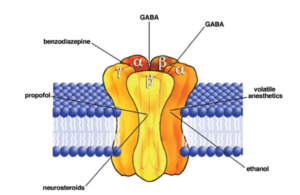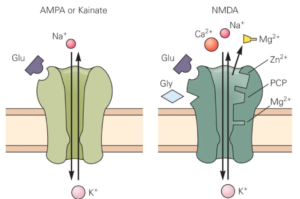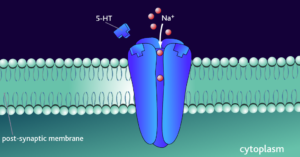• Receptors are specific protein macromolecules present in the cell membrane, cytosol or nucleus. Receptors bind to ligand (including drugs) and produce effect. There are different kind of receptors in our body. Ionotropic or ion channel linked receptor is among them.
• Ionotropic receptors are ligand gated ion channel made up of three, four or five protein subunits that together form an ion-conducting pore in the center of receptor.
• Ionotropic receptors are target for various neurotransmitters and therapeutic substances.
Table 1- Different types of Ionotropic Receptor (Source- Encyclopedia of Neuroscience. 2009 edition)
Structure of Ionotropic Receptors
• They contain 2 functional domains; an extracellular site to which neurotransmitters or other ligands bind and a membrane spanning domain that form ion channel. The ion channel allows diffusion of ions down the concentration gradient. The ions cross the membrane phospholipid bilayer through ion channel.
• When the neurotransmitter binds to one or more subunits of ionotropic channel, a conformational change occur which passes to closely associated ion channel resulting in alteration of channel properties. The modulation of ion channel depends on the length of time the neurotransmitter binds to extracellular site.
• They mediate rapid onset and rapidly reversible synaptic transmission usually in milliseconds.
Explanation of some important ionotropic receptors
GABA Receptor
• They are important ionotropic receptors which respond to GABA (Gamma Amino Butyric Acid)- the major inhibitory neurotransmitter in CNS.
• It consists of 5 subunits and are located in the neurons of the brain.

Figure 1- GABA receptor and different drugs which bind to it
Types
-
- They are classified into two types based on ion specificity: GABAA and GABAB. GABAA receptors are linked to Cl– Binding of GABA to this receptor open chloride channel and Cl– ions flow inside the cell causing hyperpolarization.
- GABAB receptors are linked to G-protein. Hence, they are classified under G-protein coupled receptor though they cause opening of K+
- A third type of GABA receptor was discovered and named GABAC, but later it is categorized as a subtype of GABAA Thus, the ionotropic GABA receptor consist of GABAA and GABAAƿ receptor.
Function
• They are main inhibitory receptor present in brain whose activation decreases neuronal firing. They play important role in inducing sleep, relieving anxiety and calming person.
• Their dysfunction leads to disorder like insomnia, anxiety, epilepsy and chronic pain.
Pharmacological Implication
• They are targets of many drugs due to their may allosteric sites. Various CNS depressant drugs like anti-convulsant, general anesthetics, analgesic and sedative drugs act on GABA receptor to show their action.
• Benzodiazepines increase frequency of opening of Cl- channel leading to inhibition and relieve anxiety and insomnia. Ethanol and barbiturates also act on GABA-A receptor and increase influx of chloride ions.
Glutamate Receptors
• Ionotropic glutamate receptors are composed of 4 subunits. They are excitatory neurotransmitter present in CNS.
• Each subunit consists of three domains; amino-terminal domain, ligand binding domain and transmembrane domain. The amino terminal domain is responsible for structural stability of receptor, ligand binding domain binds the ligand or glutamate and transmembrane domain forms ion channel.

Figure 2- Glutamate receptor (NMDA and AMPA receptor)
Types
• Glutamate receptors are of two types based on the ligand they bind with: NMDA (N-Methyl D-Aspartate) receptor and AMPA (α-amino-3-hydroxy-5-methyl-4-isoxazolepropionic acid) receptor.
Function
• They are main excitatory receptors of the CNS. The NMDA receptor are responsible for regulating memory and synaptic plasticity.
• They are found to be associated in Parkinson’s disease, Huntington’s disease, aching, seizures, autism and ADHD (Attention Deficit Hyperactivity Disorder).
• Overstimulation of glutamate receptors causes neurodegeneration and neuronal damage through excitotoxicity.
Pharmacological Implications
• The drug acting on glutamate receptor can be divided into two categories; agonist and antagonist.
• The agonists at NMDA receptor include glutamate, glycine, D-cycloserine and quinolinate. The agonists at AMPA receptor are glutamate, AMPA, Domoic acid and Quisqualic acid.
• The antagonists at NMDA receptor are ketamine, tramadol, kynurenic acid etc. The antagonists at AMPA receptor are kynurenic acid, perampanel etc.
Nicotinic Acetylcholine Receptor
• They are made up of 5 subunits two α, one β, one ɛ, and one δ subunits arranged around a central pore. They are found in CNS, PNS and neuromuscular junction.
• They respond to neurotransmitter acetylcholine and also nicotine. Hence, their name id derived. Binding of acetylcholine to α subunit increases affinity of another α subunit and brings confirmation changes in receptor.
• The ion channel allows movement of sodium and potassium ions.

Figure 3- Nicotinic Acetylcholine receptor
Function
• They help in transfer of nerve impulse form motor neuron to skeletal muscle fiber and cause excitation of skeletal muscle.
Pharmacological Implication
• They are attractive therapeutic targets for potentiating or inhibiting cholinergic transmission.
• Agonists are cholinergic drugs like methacholine, nicotine, choline, lobeline and cytisine. Antagonist are neuromuscular blockers like D-tubocurarine, pancuronium etc which cause paralysis of skeletal muscle.
Serotonin 5-HT3 receptors
• All other serotonin receptors are G-protein coupled receptor except this one. They consist of 5 subunits around a central ion channel which is permeable to sodium, potassium and calcium ions.
• They are located throughout the CNS and PNS. However, their action is more observed in CTZ (Chemoreceptor Trigger Zone) of brain.

Figure 4- Serotonin 5-HT3 receptor
Function
• Binding of serotonin to this channel generate action potential resulting in activation of CTZ neurons and process of emesis (vomiting).
Pharmacological Implication
• Antagonist of these receptors are important anti-emetic drugs. Examples are ondansetron, tropisetron and granisetron.
• Some of its antagonist have important application as anxiolytic and antipsychotics.
Reference
- https://en.wikipedia.org/wiki/Ionotropic_GABA_receptor
- https://en.wikipedia.org/wiki/Neuromuscular-blocking_drug
- https://link.springer.com/referenceworkentry/10.1007%2F978-3-540-29678-2_2596
- https://human-memory.net/ionotropic-receptor/
- Traynelis SF, Wollmuth LP, McBain CJ, Menniti FS, Vance KM, Ogden KK et al.Glutamate Receptor Ion Channels: Structure, Regulation, and Function. Pharmacol Rev. 2010; 62(3): 405–496.
- Masiulis S, Desai R, Uchański T, Martin IS, Laverty D, Karia D. GABAA receptor signaling mechanisms revealed by structural pharmacology. Nature. 2019; 565: 454–459.
- Bouzat C, Sine SM. Nicotinic acetylcholine receptors at the single‐channel level. Br J Pharmacol. 2018; 175(11): 1785–1788.
- Jane D. Ionotropic Glutamate Receptors. xPharm: The Comprehensive Pharmacology Reference. 2007; 1-5.